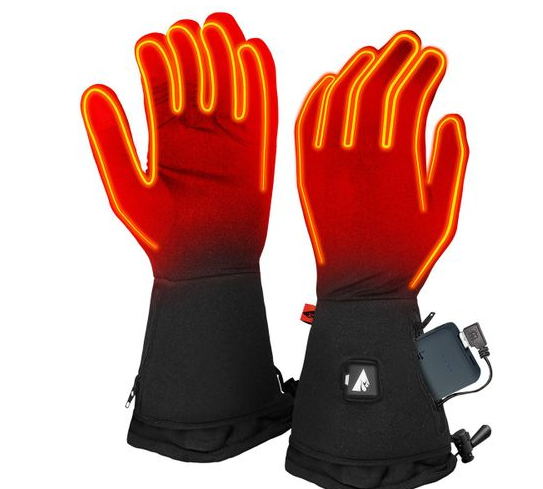
Heated gloves are a great way to keep your hands warm and comfortable in cold weather. They use rechargeable batteries and heating elements to provide warmth and can be adjusted to different heat levels.
However, like any electrical device, heated gloves also come with some potential risks and problems. In this post, we will explore some of the common issues of heated gloves and how to use them safely.
Common Problems of Heated Gloves
Heated gloves are not perfect and may have some drawbacks or malfunctions. Here are some of the common problems you may encounter when using heated gloves:
- Battery life: Depending on the heat level and the quality of the battery, heated gloves may last from 2.5 to 8 hours on a full charge. However, over time, the battery capacity may degrade and reduce the performance of the gloves. To extend the battery life, it is recommended to charge the batteries every 3 months for long-term storage and after each use for regular use.
- Heating unevenness: Some heated gloves may not heat up evenly or consistently throughout the glove. This may result in cold spots or hot spots that can affect your comfort and safety. To avoid this, you should look for heated gloves that have heating elements that cover the entire hand, fingers, and thumb.
- Water resistance: Heated gloves are usually made of water-resistant materials, but they are not waterproof. This means that they can withstand some moisture or snow, but not submersion or heavy rain. If your heated gloves get wet, they may stop working or even cause a short circuit or fire hazard. To prevent this, you should dry your heated gloves as soon as possible and avoid exposing them to excessive water.
- Size and fit: Heated gloves come in different sizes and shapes, but they may not fit everyone perfectly. If your heated gloves are too tight, they may restrict your blood circulation and cause numbness or tingling in your fingers. If your heated gloves are too loose, they may not provide enough insulation and warmth. To ensure a proper fit, you should measure your hand size and follow the manufacturer’s sizing guide.
Recommended: Top 10 heated Gloves
Top Safety Issues of Heated Gloves
Heated gloves are generally safe to use, but they also pose some potential hazards if not used properly. Here are some of the top safety issues of heated gloves and how to avoid them:
- Burns: Heated gloves can reach temperatures up to 100 degrees Celsius or more, which can cause burns if exposed for too long. This is especially dangerous for people who have problems sensing hot or cold objects (due to diabetes, Raynaud’s disease or similar) or children who may not be aware of the heat level. To prevent burns, you should consult your doctor before using heated gloves if you have any medical conditions that affect your temperature sensitivity. You should also check your hands regularly for reddening of the skin and adjust the heat level accordingly.
- Electric shock: Heated gloves use electricity to generate heat, which can cause electric shock if the wires or batteries are damaged or exposed. This can result in injury or even death if the current is high enough. To prevent electric shock, you should inspect your heated gloves regularly for any signs of wear and tear, such as fraying, cracking, or puncturing. You should also avoid washing your heated gloves in a washing machine or dryer, as this can damage the heating elements and wires. If you notice any defects or malfunctions in your heated gloves, you should stop using them immediately and contact the manufacturer for repair or replacement.
- Fire: Heated gloves can also cause fire if they overheat or come into contact with flammable materials. This can happen if you leave your heated gloves on high heat for too long, store them near a heat source, or expose them to sparks or flames. To prevent fire, you should always turn off your heated gloves when not in use and store them in a cool and dry place away from any potential fire hazards. You should also never modify or tamper with your heated gloves, as this can compromise their safety features and increase the risk of fire.
Tips For Using Safely
- Read the instructions: Before using your heated gloves, you should read the manufacturer’s instructions carefully and follow them accordingly. This will help you understand how to operate, charge, and maintain your heated gloves properly.
- Choose the right size and type: You should choose heated gloves that fit your hands well and suit your needs. There are different types of heated gloves, such as fingerless, full-fingered, or mittens. You should also consider the battery life, heating level, and water resistance of your heated gloves.
- Check the temperature: You should always check the temperature of your heated gloves before putting them on and adjust it according to your preference and comfort. You should also monitor your hands for any signs of overheating or burning, such as redness, swelling, or blisters.
- Keep them dry: You should avoid getting your heated gloves wet, as this can damage the heating elements and wires and cause electric shock or fire. If your heated gloves get wet, you should turn them off and dry them as soon as possible.
- Store them safely: You should store your heated gloves in a cool and dry place away from any heat sources or flammable materials. You should also remove the batteries from your heated gloves when not in use and charge them regularly.
Recommended: Top 10 heated Gloves
Conclusion
Heated gloves are a useful accessory for keeping your hands warm in cold weather. However, they also have some drawbacks and dangers that you should be aware of.
By following these tips and precautions, you can enjoy the benefits of heated gloves without compromising your safety. Stay warm and stay safe!
